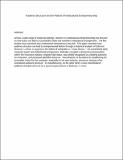Audience Structure and the Failure of Institutional Entrepreneurship
Author(s)
Kahl, Steven J.; Liegel, Gregory J.; Yates, JoAnne
DownloadYates_Audience Structure.pdf (685.4Kb)
OPEN_ACCESS_POLICY
Open Access Policy
Creative Commons Attribution-Noncommercial-Share Alike
Terms of use
Metadata
Show full item recordAbstract
Purpose – The broader aim of this research is twofold. First, we aim to better understand how the business computer was conceptualized and used within U.S. industry. Second, this research investigates the role of social factors such as relational structure, institutional entrepreneurs, and position in the formation of conceptualizations of new technologies.
Design/methodological/approach – This paper is theoretically motivated in the sense that it responds to the lack of attention to the failure of institutional entrepreneurs to change belief systems. Through detailed archival, network, and descriptive statistical analysis, the paper shows how the failed institutional entrepreneur fits conventional explanations for success. The paper then analyzes two matched cases, comparing the insurance industry's rejection of the institutional entrepreneur with manufacturing's acceptance, in order to identify what is missing in current explanations of institutional entrepreneurs.
Findings – Our analysis reveals that the role of the audience structure in interpreting the institutional entrepreneur's message influences the change outcome. In our case, the institutional entrepreneur's view of the computer as a brain that supported decision-oriented applications did not fit with views of the insurance groups who had centralized authority over interpreting the computer. Because manufacturing had less centralized control in its discourse around the computer, there were fewer constraints on assimilation, allowing the entrepreneur's views to resonate with some of the occupational groups.
Research limitations/implications – This paper develops a theoretical approach to institutional entrepreneurship that situates the entrepreneurial efforts of individual actors within a system characterized by the structure of its audience and subject to distinct historical macro-structural processes that present significant obstacles to the realization of their entrepreneurial projects.
Date issued
2012-01Department
Sloan School of ManagementJournal
Advances in Strategic Management
Publisher
Emerald Group Publishing Limited
Citation
Kahl, Steven J., Gregory J. Liegel, and JoAnne Yates (2012), Audience Structure and the Failure of Institutional Entrepreneurship, in Steven J. Kahl, Brian S. Silverman, Michael A. Cusumano (ed.) History and Strategy (Advances in Strategic Management, Volume 29), Emerald Group Publishing Limited, pp.275-313.
Version: Author's final manuscript
ISBN
978-1-78190-024-6
ISSN
0742-3322